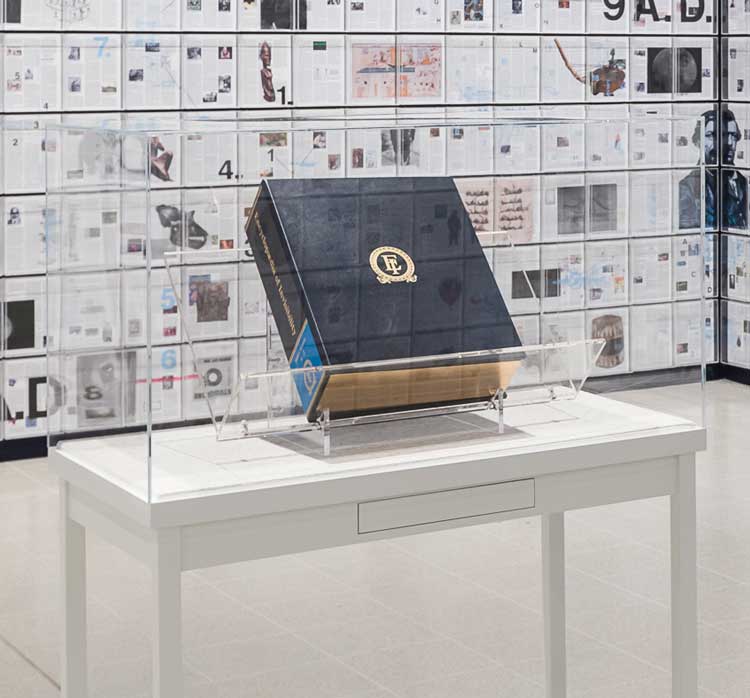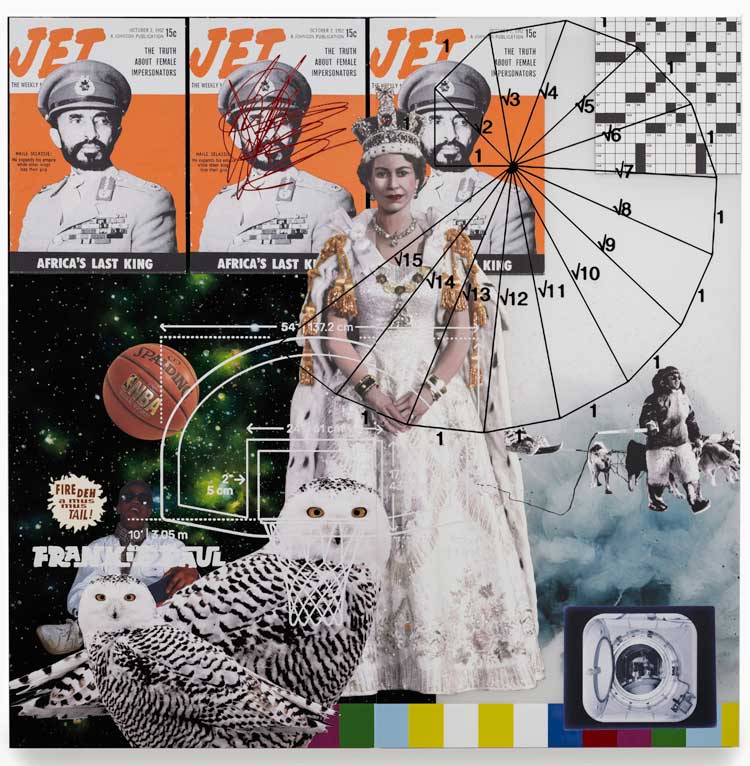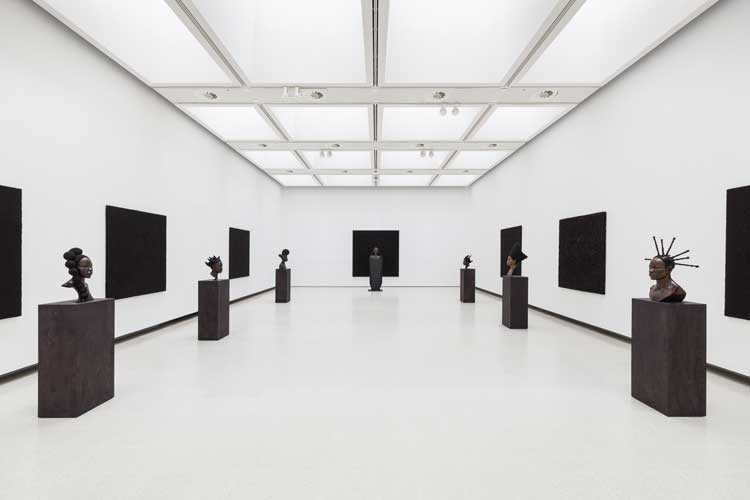
Tavares Strachan, Black Star, 2024. Installation view, Tavares Strachan: There Is Light Somewhere, Hayward Gallery, London, 18 June – 1 September 2024. Photo: Mark Blower. Courtesy the artist and the Hayward Gallery.
Hayward Gallery, London
18 June – 1 September 2024
by DAVID TRIGG
The title of this exhibition, There Is Light Somewhere, has an optimistic ring, suggesting that, however dark a situation may be, hope can still be found. It is borrowed from a 1964 quote by the African American writer and civil rights activist James Baldwin: “It is necessary, while in darkness, to know that there is a light somewhere, to know that in oneself, waiting to be found, there is a light.” Baldwin’s words are a touchstone for the New York-based, Bahamian artist Tavares Strachan (b1979), who presents them in blinking blue and yellow neon and in a hypnotic sound installation that reverberates around the ground-floor spaces of this impressive mid-career survey at the Hayward Gallery. Strachan has spent the last 20 years scrutinising the darkness, bringing to light people and events that have been overlooked, ignored and excluded from mainstream history.
.jpg)
Tavares Strachan, The Encyclopedia of Invisibility, 2014-18, and Six Thousand Years, 2018. Installation view, Tavares Strachan: There Is Light Somewhere, Hayward Gallery, London, 18 June – 1 September 2024. Photo: Mark Blower. Courtesy the artist and the Hayward Gallery.
Lost and underrepresented stories of black history are central to Strachan’s multidisciplinary practice. As a child growing up in Nassau, he pored over his grandfather’s Encyclopaedia Britannica and was curious as to why it mentioned no one from his community in the Bahamas. This formative experience is the driving force behind The Encyclopedia of Invisibility (2014-18), a huge 2,550-page leather-bound volume containing more than 17,000 entries dedicated to people, things and concepts that have been neglected or omitted from “official” accounts. Included in the weighty tome are texts on the Mino, an all-female army from the Kingdom of Dahomey (present day Benin); Robert Smalls, an enslaved African American who became one of the first Black congressmen in the United States; and Rosetta Tharpe, the influential 1930s American singer referred to as “the Godmother of rock’n’roll”.

Tavares Strachan, The Encyclopedia of Invisibility, 2014-18. Installation view, Tavares Strachan: There Is Light Somewhere, Hayward Gallery, London, 18 June – 1 September 2024. Photo: Mark Blower. Courtesy the artist and the Hayward Gallery.
The book itself is tantalisingly inaccessible, displayed in a Perspex case at the heart of a floor-to-ceiling, room-sized installation of facsimile pages, many of which have been obscured by overlaid drawings, diagrams and collaged ephemera. Many of the texts remain legible, though some entries are completely defaced and others are hung so high they cannot be read. While this speaks to the transient nature of knowledge, subject as it is to bias and distortion, it seems an odd decision for an artist who wants to draw attention to hidden histories.
,-2024-(1).jpg)
Tavares Strachan, Ruin of a Giant (King Tubby), 2024. Installation view, Tavares Strachan: There Is Light Somewhere, Hayward Gallery, London, 18 June – 1 September 2024. Photo: Mark Blower. Courtesy the artist and the Hayward Gallery.
The question of how to give visibility to stories that have been obscured is one that Strachan answers in a variety of ways and with varying degrees of success. His 2024 series of huge, patinated bronze busts, Ruin of a Giant, are scattered throughout the show, depicting figures such as the Jamaican political activist Marcus Garvey, dub music pioneer King Tubby and the American abolitionist Harriet Tubman. Resembling the relics of a lost civilisation with deep fissures scarring their surfaces, these enormous sculptures look as if they have been exhumed after being buried for centuries. Their monumental appearance raises questions central to Strachan’s practice: who gets to be commemorated and who gets to decide?

Tavares Strachan, Every Tongue Shall Confess, 2019. Two panels, oil, enamel, and pigment on acrylic, 84 x 42 x 2 in. (213.4 x 106.7 x 5.1 cm) each, 84 x 84 x 2 in. (213.4 x 213.4 x 5.1 cm) overall. Courtesy of the artist. Photo: Miho Suzuki.
References to diverse histories abound in Strachan’s Invisibility Paintings (2018-23), a series of elaborate, pop-art-inflected compositions that weave together references to people and events from the worlds of politics, science, music and sport. In Every Tongue Shall Confess (2019), an image of Queen Elizabeth II is juxtaposed with another of Haile Selassie I, Emperor of Ethiopia. The backstory alluded to here is an encounter between the two monarchs at which, according to the wall text, the queen bowed before the emperor in recognition of his superior rank. The veracity of this account, however, is hotly disputed, a fact of which Strachan must surely be aware. Is this, then, a deliberate attempt to mislead viewers, or a way of highlighting how history can be distorted, especially when such claims are bandied about unchallenged on social media?

Tavares Strachan, A Map of the Crown series, 2022-24, and Mind Fields series, 2023-24. Installation view, Tavares Strachan: There Is Light Somewhere, Hayward Gallery, London, 18 June – 1 September 2024. Photo: Mark Blower. Courtesy the artist and the Hayward Gallery.
Strachan is a seriously ambitious artist and another significant theme here is exploration. He has trekked to the north pole, following in the footsteps of Black polar explorer Matthew Henson (who claimed to have been the first explorer to reach the north pole on the Robert Peary-led expedition of 1908-9), and extracted a 4.5-tonne block of ice from the Alaskan Arctic, shipping it back to the Bahamas and exhibiting it at his former elementary school. His desire to “get the Bahamas involved in the global exploration conversation” saw him train as a cosmonaut at the Yuri Gagarin Training Centre in Star City, Russia, before returning home to establish the Bahamian version of Nasa and blast a sugarcane-fuelled rocket into the Earth’s stratosphere. He has even fired into orbit a golden bust of the first African American astronaut Robert Henry Lawrence Jr, who died during training in 1967.
.jpg)
Tavares Strachan, Black Star, 2024. Installation view, Tavares Strachan: There Is Light Somewhere, Hayward Gallery, London, 18 June – 1 September 2024. Photo: Mark Blower. Courtesy the artist and the Hayward Gallery.
Upstairs, on the Hayward’s sculpture terrace, is a 14-metre-long model of the SS Yarmouth, the flagship of the Black Star Line shipping company, founded by Marcus Garvey in 1920 with the aim of facilitating trade and travel between the US, the Caribbean and Africa. As part of the Back-to-Africa movement, it was a potent symbol of Pan-Africanism even though none of the ships ever reached Africa. Overlooking Waterloo Bridge and appearing like a monument to Garvey’s failed project, Strachan’s majestic ship floats in a large pool of water and blasts out a head-nodding, dub-soaked soundtrack.
,-2023.jpg)
Tavares Strachan, Inner Elder (Nina Simone as Queen of Sheba), 2023. Ceramic, 39 ⅜ H x 23 ⅝ W x 23 ⅝ D in (100 x 60 x 60 cm). Courtesy of the Artist and Marian Goodman Gallery.
Strachan revels in making connections between people, places and time periods. In his 2020 series Distant Relatives, plaster busts of eminent figures from the African diaspora (including Nina Simone, Mary Seacole and James Baldwin) are mounted on brass stands, their faces partially hidden by traditional African and New Guinea masks. Similarly, his Inner Elder series from 2023 link more of the artist’s modern cultural heroes with ancient monarchs. In one, the head of African Roman emperor Septimius Severus is split open to reveal a likeness of the South African anti-apartheid campaigner Steve Biko emerging from a bulbous ceramic vessel. Such works reflect Strachan’s impulse to connect with the voices of ancestors, an imaginative remapping of connections that were disrupted by 300 years of slavery. But, like much in Strachan’s work, the associations (beyond race) are not easily discerned.
,-2024.jpg)
Tavares Strachan, Intergalactic Palace, 2024, and Ruin of a Giant (King Tubby), 2024. Installation view, Tavares Strachan: There Is Light Somewhere, Hayward Gallery, London, 18 June – 1 September 2024. Photo: Mark Blower. Courtesy the artist and the Hayward Gallery.
More lucid is the magnificent installation Intergalactic Palace (2024), a giant thatched hut inspired by Ugandan ceremonial structures, where kings have been crowned since the 14th century. Inside, sheet music lines the walls and ceiling: African American spirituals, jazz and blues standards, rock’n’roll classics – the foundations of modern music. At the centre of the hut, emphasising the point, is a golden DJ booth surrounded by busts of black musicians. A constellation of lights fades on and off as Strachan’s sound collage, Sonic Encyclopedia (2024), plays the voices of Louis Armstrong, Muhammad Ali, Bob Marley and many more relating to the history of Black music and civil rights into the space. It is a potent multisensory reminder of the rich cultural contribution made to the world made by those whose ancestry traces back to Africa. Despite the continuing presence of racial injustice, Strachan’s rich and multilayered art shows us that there is indeed “light somewhere”.